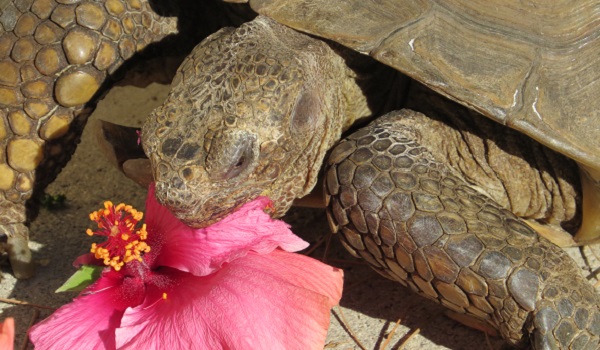Speedy
Photos courtesy of the California Turtle & Tortoise Club (CTTC): Valley Chapter
Text by Karen Berry: Treasurer | Adoption Chair
Speedy came to Valley Chapter in September, 2017. His caretaker was an elderly woman with significant health issues, including multiple recent hospitalizations. She had him for 35 years, and he was an adult when she got him. Because of her health, she was downsizing and selling her home, and could not take him with her.
Speedy had a very nice and spacious enclosure with grass, weeds, and rose bushes, plus a small shed where he slept at night. His caretaker said she was concerned about him because he hadn’t been eating much for the last couple of months, and she thought the squirrels were eating the food she put out for him daily. He was extremely light to pick up, and felt like an empty shell, which was definitely a concern. His head was flat, and the crest along the center of his head was very pronounced, which it is not in a healthy tortoise. The sides of his head at the junction with his neck were sunken in, his legs were bony, and he had no muscle tone anywhere in his body. His eyes, too, were partially sunken, reflecting some dehydration.
He was seen by the vet the next day, weighed in at barely over 6 pounds, received fluids and vitamin injections and had an overall treatment plan developed. Putting weight back on him was going to be a challenge, as it had to be done slowly to not overwhelm his stomach. He would be monitored for a possible infection, and as soon as a fecal sample could be provided, it would be tested for parasites. He would not be allowed to hibernate because of his poor physical condition.
We kept him warm to increase activity and hopefully his appetite. He was also given warm soaks for hydration. He would not drink out a dish, or while soaking, and still doesn’t. He had no interest in eating, even when offered organic iceberg or romaine, the "junk food" that almost every tortoise will eat. He received tube feedings in small amounts to attempt to jump start his appetite without putting too much into his stomach right away. It was going to be a long and bumpy road until he regained interest in solid food. He actually regurgitated a large amount of whitish gelatinous "goo" during a vet check-up. He was placed on a broad-spectrum antibiotic to combat a possible internal infection.
He gradually regained interest in solid food, and his Critical Care was given in mush form with chopped dandelion greens, grape leaves, plus organic iceberg (for extra water) mixed in with it. He was outside for sunning every day, and very slowly started grazing on grass, weeds, and flowers. Once he started eating on his own, his grazing was supplemented with commercial pellets of different kinds, soaked to "mush," with chopped greens mixed in. The commercial food has only been used for calorie supplementation and fiber.
Since he came to us, he has put on a little over a pound, which is a definite improvement on his initial condition. He still has a very long way to go to regain his full health, and be adopted to a new home.
Jan. 2, 2021 Update
In an e-mail, our adoption chair informed me that poor Speedy has passed away. I'll try to get more details later, if I can. — CH
